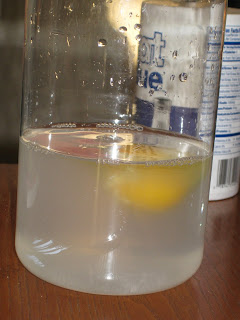Last year, I received this Pop Bottle Science Kit for a gift. We decided to try it out today with some supplies that we already had hanging around.
For this experiment, you need your pop bottle with the top part removed (or a large jar will do), water, two eggs, and salt.
Fill your container 1/4 cup full of water. Break an uncooked egg into the water.
The egg yolk should sink to the bottom of the container.
Dump out the water and egg and fill up the container 1/4 full of water. Add salt and stir until the salt doesn't dissolve anymore.
Dad is checking to see if we have any undissolved salt in the water. It won't dissolve, so that must mean we have the right amount of salt for this experiment.
Break an uncooked egg into the salt water.

Now the egg yolk should float.
Slowly dribble water down the side of your container, being careful not to mix the fresh water with the salt water. Doing this is much easier if you use a turkey baster!
If the fresh water stays separate, the egg will float on top of the salt water and at the bottom of the fresh water!
According to the Pop Bottle Science Manual, this happens because: "An egg will sink in fresh water but float in salt water. Fresh water is less dense than salt water (and less dense than an egg). If you pour fresh water in the ocean, it will float around on the surface until diffusion mixes the molecules and the fresh water becomes salt water." Thanks for checking out my blog! I will be posting again soon!






















